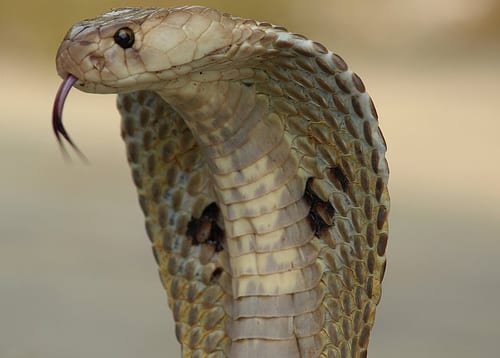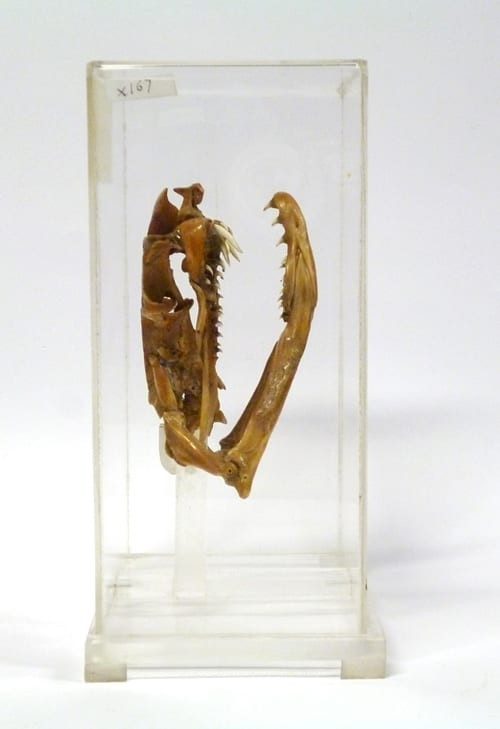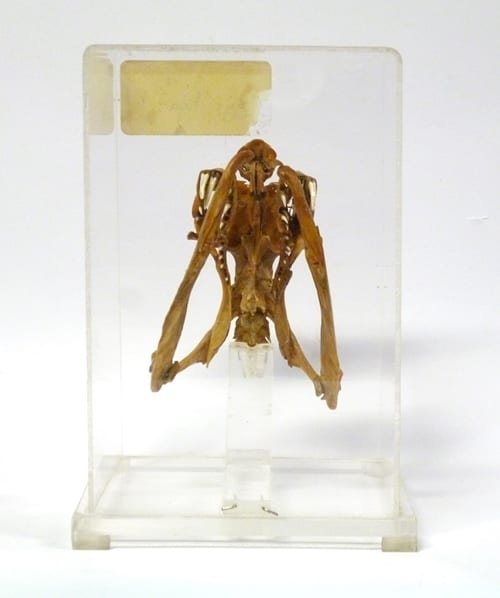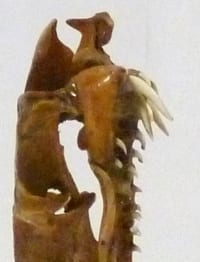Specimen of the week 227: the Indian cobra skull
By Will J Richard, on 19 February 2016
Hello blog-heads! Will Richard here tapping out another specimen of the week on my trusty keyboard. And this time I’ve picked out a pretty dangerous customer from Case 16. I’m not an ophidiophobe, though according to Wikipedia about one in three of us are, but this is certainly not a snake I’d like to tangle with.
**the Indian cobra skull**
Seriously dangerous
The Indian cobra (Naja naja) is one of the deadliest snakes in the world, responsible for an estimated 10,000 human deaths every year in India alone. They are found throughout South Asia and native to the forests, grasslands, rice paddies and urban areas where they hunt the large numbers of rats and mice drawn by human refuse. Their venom is potent though the strength depends on the age and location of the individual snake, appearing to be more lethal in those found furthest east. At its worst it has been shown to be cytotoxic (causes tissue necrosis), neurotoxic (paralyses the nervous system) and cardiotoxic (stops the heart). And although they do not actively hunt people, their relatively high numbers in populous areas inevitably leads to a lot of accidental encounters. Even the most placid of animals will bite you if you stand on it in the dark.
The hood, the bad and the ugly
And this is not an easy snake to notice. There is variation in the colour and patterning of the scales across the species’ range but they are typically plain and sandy or soil coloured. It is not a huge snake either and spends a lot of time trying to conceal itself while waiting for prey. Adults rarely exceed two metres though are relatively thickset. Their chunky appearance is accentuated by their ability to flare the loose skin directly behind their head, known as their hood. This is done using specialised muscles and ribs that stretch the hood taught and make the snake appear larger as a warning to a perceived threat: usually accompanied by loud hissing and the adoption of a defensive posture from which the cobra can strike. Very much a last chance.

Indian cobra; image by Kamalnv; CC-BY-3.0; via Wikimedia Commons
Lethal injection
The skull shows why this warning should be heeded – most noticeable are the prominent fangs. The cobra uses these to puncture the skin and, with the force generated as the snake throws itself forwards, bury them into the tissue of the victim. In approximately 40% of cases this is as far as it goes and no envenomation actually occurs, known colloquially as a “dry bite”. During envenomation (a “wet bite”) the venom, which can be considered a highly adapted form of saliva, is forced down the cobra’s hollow fangs and injected directly into the flesh. The mechanism is remarkably similar to that of a hypodermic needle. The “saliva” is produced in two glands that sit within the skull, just below the snake’s eyes, where it collects ready for use. Indian cobras have been recorded getting through as much as 60% of their total venom stock in a single attack, often biting multiple times in quick succession.
Snake harmers
Despite the apparent risks there are some animals that enjoy Indian cobras as part of their regular diet. The Indian grey mongoose (Herpestes edwardsii), for example, is famous for its daring and unbelievable reaction speeds when hunting cobra. All is not quite what it seems, however. Neurotoxins usually work by blocking specific chemical receptors that would normally allow nerve impulses to pass from nerve cells to other cells to trigger a response. The mongooses have specially adapted, “un-blockable” receptors that provide them with a significant resistance to the snake’s venom. It still isn’t nice to be bitten but it probably isn’t fatal. The king cobra (Ophiophagus hannah), another Indian cobra predator, has similarly resistant neuro-receptors. This makes it a straight “wrestling” match between two snakes one of which is three times the size and venomous itself.
…only a mother could love…
As snakes go the Indian cobra is a very attentive mother. The female, having previously mated, will lay a small clutch of about 20 eggs in a tree hollow or buried in the ground. Throughout the seven to eight week incubation period she will guard them, only leaving her post to feed. The juveniles hatch as perfect miniatures with fully functioning venom glands.
They need no further care…
References:
Whitaker, R., Captain, A. (2004); Snakes of India: The Field Guide; Chennai, India: Draco Books
Shashidharamurthy, R., Jagadeesha, D.K., Girish, K.S., Kemparaju, K.; (2002); Variation in biochemical and pharmacological properties of Indian cobra (Naja naja naja) venom due to geographical distribution; Molecular and Cellular Biochemistry; v229; i1; pp93-101
Will Richard is the Visitor Services Assistant at the Grant Museum of Zoology
 Close
Close




